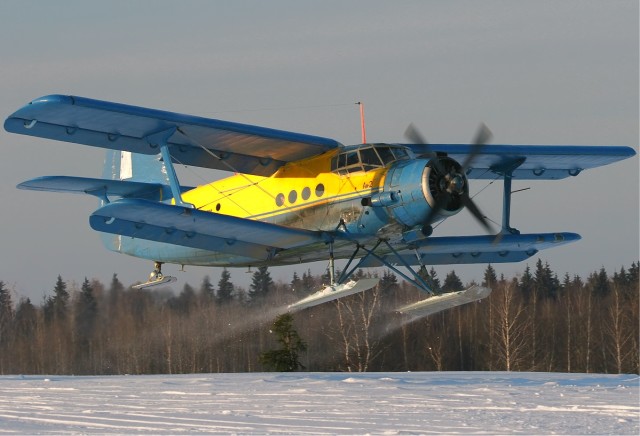
Last year, North Korea showed off a new camouflage scheme for one of its military aircraft. Kim Jong-Un himself was shown at the controls of one of the planes. The plane was not a new jet; it was a 1940’s biplane. The An-2 can fly low and very slow, useful if one wants to drop commandos behind their southern neighbor’s border without being seen on radar.
The new scheme is green on top and blue on the bottom, obscuring the plane from view both above and below. But, you may ask, why are the North Koreans still flying a bi-plane from the 40’s in 2016?
First flown in 1947, the Soviet Union developed the Antonov An-2, as they were rebuilding from World War II. On its first flight, it already seemed like an anachronism. Aviation was already in the jet age by that point. But the incredible sound design of the plane has kept it in use in the thousands around the globe for 70 years. Plus, it has some amazing features like its remarkable short take-off and landing distances. Also, it can fly backwards.
The Soviet Union and Poland built over 19,000 An-2s until 1991. China has built thousands more under license. Occasionally, the aircraft continues to be built there.
The An-2 is still flying because there is nothing else like it, according to Bernie Leighton, an aviation writer who has flown in an An-2 in Belarus. “If you need an aircraft that can carry 10 soldiers, people or goats, that can take off from anywhere and land anywhere – it is either that or a helicopter.”
The plane was not designed for passenger comfort. “First, it’s a tail-dragger, so once you climb the steps into the cabin, everything is leaning distinctly rearwards. It is also a very ‘firm’ aircraft. You feel every single bump in the terrain, every control surface movement,” says Leighton
It’s extremely loud and warm. “Still, it’s an absolute blast once you get it airborne.”
The archaic design brings a distinct benefit. The two sets of wings generate lots of lift, which is how it can take off in a very short distance. It also means that the An-2’s minimum speed is extremely low. It can still be flown under full control at 25 mph.
To compare, an average Cessna will stall at air speeds below 50 mph. The low speed makes the An-2 popular with parachute training and skydiving schools. It also means that the plane can basically hover, something pilots like to show off at airshows. If the wind is strong enough, the pilot can fly into a headwind and hover or even move backwards.
If you think that sounds impossible, talk to Bill Leary. He’s the flight manager of the UK An-2 Club which flies out of Popham Airfield near Basingstoke. He has 14 years of experience flying an ex-Hungarian An-2.
It’s the control surfaces on the wings that give the An-2 the ability to hover, he said. On the front of the wings are flexible panels called leading-edge slats. They are often deployed during landing to increase wind resistance and bring down the speed of the aircraft. There are similar panels called flaps on the rear of the wings, which also lower the aircraft’s speed. The flaps also increase lift by changing the shape of the wing. The An-2 has flaps along the entire back of the lower wings along with more on the top wings. This creates a lot of lift and allows the incredibly slow minimum speeds.
“If you’ve got a strong enough wind, let’s say 15 to 20 knots, you can ‘hover’ the aeroplane,” says Leary. “You put all of the flaps down and leading-edge slats on the front of the wing, You turn the aircraft 40 degrees into the wind and give the engine an awful lot of power and you can hold it there.”
Leary finds the An-2 to be a joy to fly, but it does need a lot of attention. It is sensitive to movement on the control stick. It takes very little effort to get the airplane to climb, but turning takes a great deal of physical effort. There are no computers to move the flying surfaces and no hydraulic controls. “It’s all down to cables and rods and human effort,” says Leary. “You need the muscles of an ironmonger.”
It might have been a famous aircraft had it been built in a non-Communist country. “The An-2 only kills you if you do something stupid in it,” says Leighton. “It’s not a comfortable aircraft,
but it really is extremely safe.” That, plus the backwards flying ability, make this a one-of-a-kind airplane.
Image by By Sergey Ryabtsev – http://www2.airliners.net/photo/Radonezh/Antonov-An-2R/1501661/L/, GFDL 1.2, https://commons.wikimedia.org/w/index.php?curid=16395284

Δεν υπάρχουν σχόλια:
Δημοσίευση σχολίου